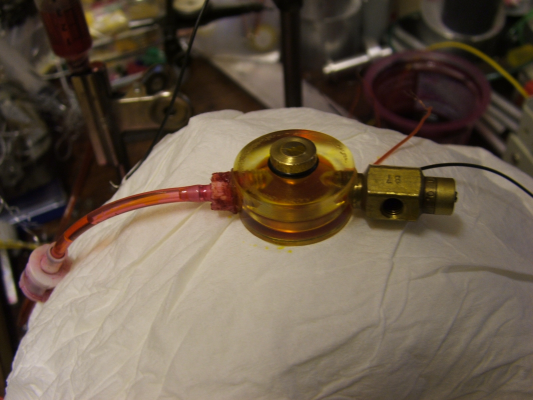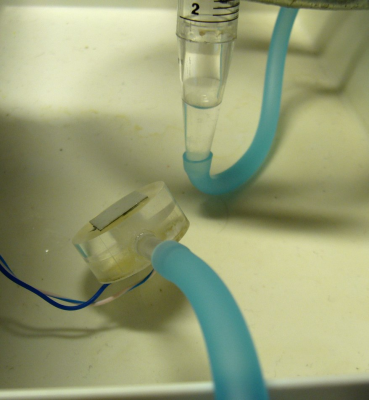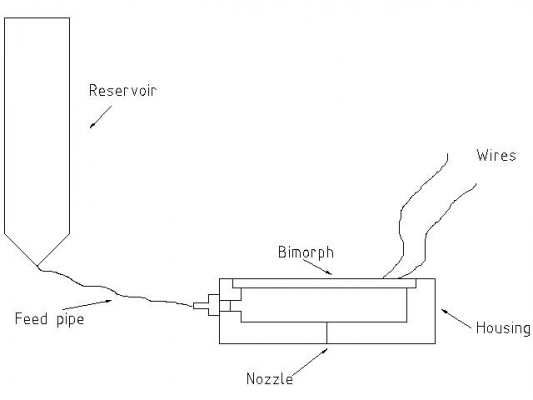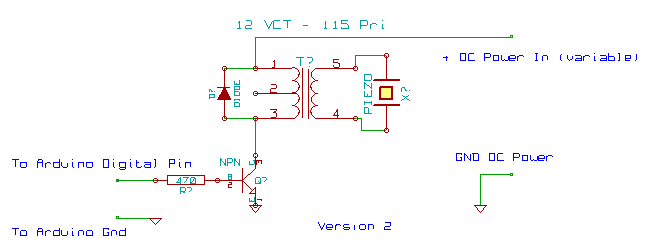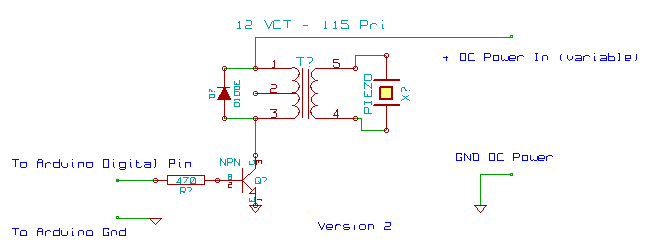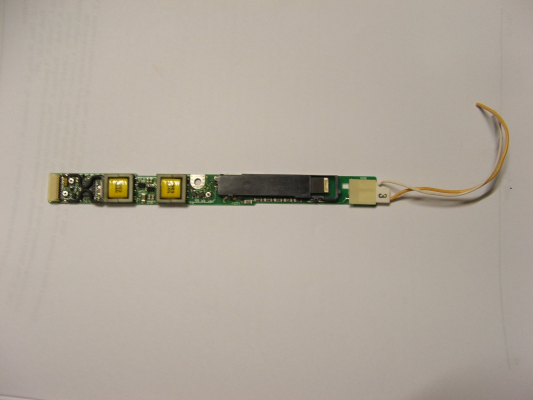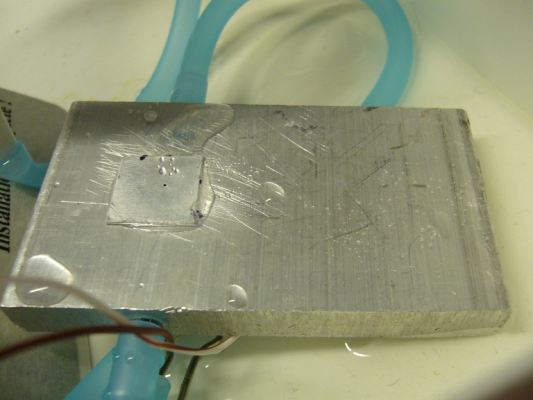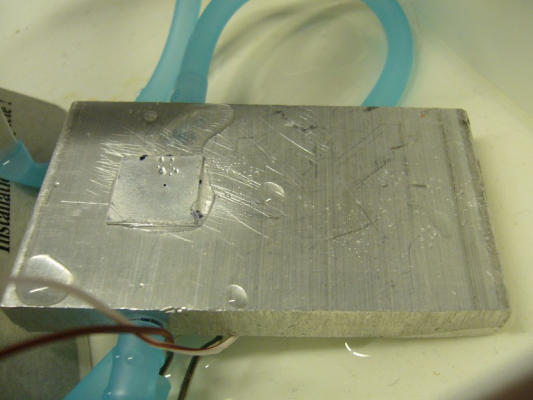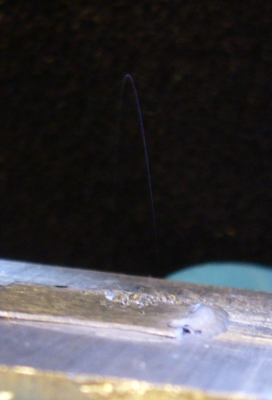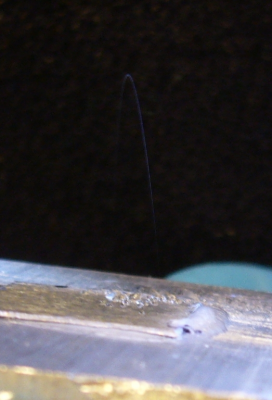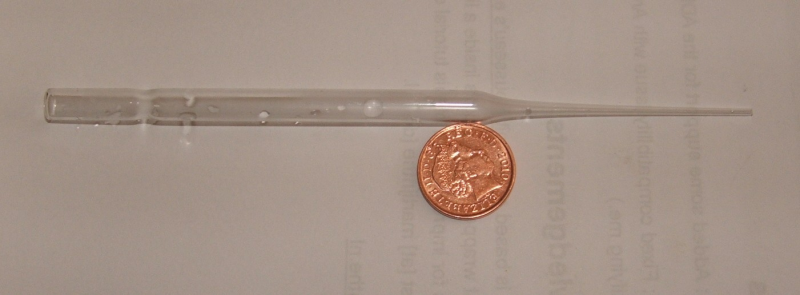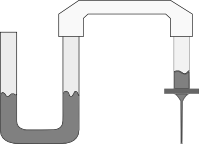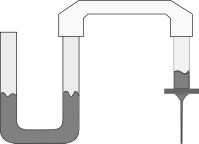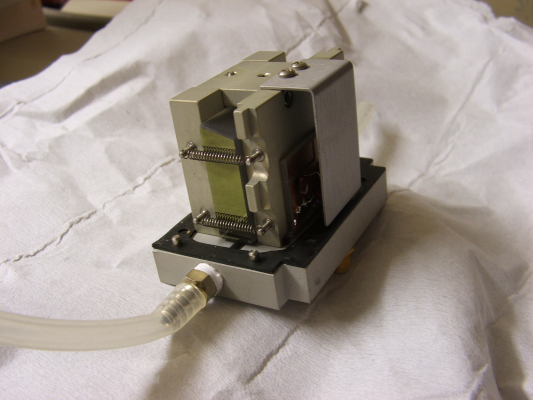DIY printhead
Posted by johnrpm
|
Re: DIY printhead September 09, 2010 01:05PM |
Registered: 15 years ago Posts: 537 |
Hello,
Since 0.25mm will not require any special tooling or stock purchases, I will be willing to make up one nozzle (possibly two) for testing purposes. Please supply me with a blueprint of the nozzles exact dimensions and include tolerances in critical areas. At this time, I have the following brass hex stock available: 5/16, 9/16, 1/2 (approximately 8mm, 11mm, and 13mm)
I will also only supply this nozzle to somebody who can test it in the near future.
My "unofficial policy" (subject to change on my whim, the day of the week, what side I got out of bed in the morning, the phase of the moon, what I ate for breakfast, or any of about several thousand other variables) is that for something that appears to be promising I'll make a test part or two for free as long as I don't have to buy any tooling, materials, etc. I also consider how difficult it would be to manufacture 100 or more of such item when making my determination.
i.e.
If it is made out of an easily machined material, appears to be something that has a reasonable chance of working, and can be made cheaply the chances I will make a test item are very good.
If, on the other hand, the item is made out of some exotic material that eats end-mills for dinner (even with coolent), costs $500.00 per pound, and looks like only one person would ever be interested in it then I'll quote time and materials.
Of course, there are various stages of quotes for scenarios that are between the two extremes.
If a nozzle with 0.25mm orifice works, I'll be more confident about taking risk and purchasing tooling in order to make nozzles with a smaller orifice.
Regards,
Brian
>
> reifsnyderb can make to us nozzles with 0.25mm!!
> for the same price of actual extruder nozzles. So
> right now or we ask to reifsnyderb for a nozzle of
> 0.25mm or to VDX for a nozzle with a smaller value
> up to 0.1mm or up 0.02mm done using his laser :-)
Since 0.25mm will not require any special tooling or stock purchases, I will be willing to make up one nozzle (possibly two) for testing purposes. Please supply me with a blueprint of the nozzles exact dimensions and include tolerances in critical areas. At this time, I have the following brass hex stock available: 5/16, 9/16, 1/2 (approximately 8mm, 11mm, and 13mm)
I will also only supply this nozzle to somebody who can test it in the near future.
My "unofficial policy" (subject to change on my whim, the day of the week, what side I got out of bed in the morning, the phase of the moon, what I ate for breakfast, or any of about several thousand other variables) is that for something that appears to be promising I'll make a test part or two for free as long as I don't have to buy any tooling, materials, etc. I also consider how difficult it would be to manufacture 100 or more of such item when making my determination.
i.e.
If it is made out of an easily machined material, appears to be something that has a reasonable chance of working, and can be made cheaply the chances I will make a test item are very good.
If, on the other hand, the item is made out of some exotic material that eats end-mills for dinner (even with coolent), costs $500.00 per pound, and looks like only one person would ever be interested in it then I'll quote time and materials.
Of course, there are various stages of quotes for scenarios that are between the two extremes.
If a nozzle with 0.25mm orifice works, I'll be more confident about taking risk and purchasing tooling in order to make nozzles with a smaller orifice.
Regards,
Brian
>
> reifsnyderb can make to us nozzles with 0.25mm!!
> for the same price of actual extruder nozzles. So
> right now or we ask to reifsnyderb for a nozzle of
> 0.25mm or to VDX for a nozzle with a smaller value
> up to 0.1mm or up 0.02mm done using his laser :-)
|
Re: DIY printhead September 09, 2010 02:45PM |
Admin Registered: 16 years ago Posts: 13,884 |
... i'll check at weekend, what materaials/thicknesses are in my stock and which method will work ...
Viktor
--------
Aufruf zum Projekt "Müll-freie Meere" - [reprap.org] -- Deutsche Facebook-Gruppe - [www.facebook.com]
Call for the project "garbage-free seas" - [reprap.org]
Viktor
--------
Aufruf zum Projekt "Müll-freie Meere" - [reprap.org] -- Deutsche Facebook-Gruppe - [www.facebook.com]
Call for the project "garbage-free seas" - [reprap.org]
|
Re: DIY printhead September 09, 2010 06:33PM |
Registered: 14 years ago Posts: 356 |
reifsnyderb and VDX, I believe we should be able to print in plastic ABS the piezo housing. We then need some kind of nozzle or metal sheet with one hole of 0.1mm (or no more higher than 0.25mm). If any of you can provide it to us, would be great.
I just can show the pictures from johnrpm and madscifi prototypes that did printed, you can take ideas and make something near to that:
FULL SIZE image.
Here is a layout:
reifsnyderb, VDX have bits of 0.1mm, can you get them also? I am sure it will make a big difference in print resolution from 0.25mm -> 0.1mm.
Edited 2 time(s). Last edit at 09/09/2010 06:37PM by casainho.
---
New cutting edge RepRap electronics, ARM 32 bits @ 100MHz runs RepRap @ 725mm/s:
[www.3dprinting-r2c2.com]
I just can show the pictures from johnrpm and madscifi prototypes that did printed, you can take ideas and make something near to that:
FULL SIZE image.
Here is a layout:
reifsnyderb, VDX have bits of 0.1mm, can you get them also? I am sure it will make a big difference in print resolution from 0.25mm -> 0.1mm.
Edited 2 time(s). Last edit at 09/09/2010 06:37PM by casainho.
---
New cutting edge RepRap electronics, ARM 32 bits @ 100MHz runs RepRap @ 725mm/s:
[www.3dprinting-r2c2.com]
|
Re: DIY printhead September 09, 2010 11:48PM |
Registered: 14 years ago Posts: 196 |
I wanted to see if a transformer based driver would work with this head so I put together the simplest one I could (without risking damage to the output devices in the atmega chip in the arduino):
The transistor is your every day standard small signal switching transistor from an old pack of radio shack transistors. Specs: Typical Hfe: 200, Max VCE: 30V, Max Ic: 800ma. Body style: TO92.
I set up the arduino to produce a 100 us pulse once every 500 ms. At 16.5 volts from the DC power supply, which results in a one hundred volt spike across the piezo, drops are generated. The driver transistor does not even get warm. I have not attempted done any other tests to determine the minimum voltage, pulse width, etc, so this is all I know at this time.
I'm not saying this is a good driver, just that it does work with this drop generator. So all of my concerns about rise times and pulse widths have been pretty much nothing more than a distraction. Live and learn, slowly sometimes.
Update 2010-09-10: Added a flyback diode to correct the flaw in the circuit as pointed out by Nophead below. A Schottky or fast recovery diode would be best, or so I've read. I've verified that this version of the driver also works with the print head, as would be expected.
Edited 1 time(s). Last edit at 09/10/2010 10:06PM by madscifi.
The transistor is your every day standard small signal switching transistor from an old pack of radio shack transistors. Specs: Typical Hfe: 200, Max VCE: 30V, Max Ic: 800ma. Body style: TO92.
I set up the arduino to produce a 100 us pulse once every 500 ms. At 16.5 volts from the DC power supply, which results in a one hundred volt spike across the piezo, drops are generated. The driver transistor does not even get warm. I have not attempted done any other tests to determine the minimum voltage, pulse width, etc, so this is all I know at this time.
I'm not saying this is a good driver, just that it does work with this drop generator. So all of my concerns about rise times and pulse widths have been pretty much nothing more than a distraction. Live and learn, slowly sometimes.
Update 2010-09-10: Added a flyback diode to correct the flaw in the circuit as pointed out by Nophead below. A Schottky or fast recovery diode would be best, or so I've read. I've verified that this version of the driver also works with the print head, as would be expected.
Edited 1 time(s). Last edit at 09/10/2010 10:06PM by madscifi.
|
Re: DIY printhead September 10, 2010 10:00AM |
Admin Registered: 17 years ago Posts: 7,879 |
You could easily exceed the 30V VCE max with that circuit. When you turn the transistor off the only thing limiting how high the collector voltage goes is the capacitance of the piezo. The voltage it reaches will depend on that capacitance and the transformer inductance and its turns ratio.
[www.hydraraptor.blogspot.com]
[www.hydraraptor.blogspot.com]
|
Re: DIY printhead September 10, 2010 11:22AM |
Registered: 14 years ago Posts: 196 |
|
Re: DIY printhead September 10, 2010 12:37PM |
Registered: 15 years ago Posts: 537 |
Hello,
At this time, I have 2 tooling issues.
The first is that the smallest drill bits, that I have, are 0.25mm. (Once you reach 0.3mm, the cost of the drill bits start really going up fast. A 0.1mm drill bit would be around $14.00.) It really isn't a matter of if I can get 0.1mm drill bits. It is a matter that I really don't have a use for them except to buy one to drill a single hole.
The second issue is that maximum RPMs that I can turn, at this time, is limited to 2800. The 0.25mm drill bits are a little tricky to drill out at 2800RPM. But, they can be done as long as I am careful. A 0.1mm drill bit would be even trickier and I really should really get the high speed (10,000 RPM) pulleys in order to do this. I think it is possible at 2800 RPMs, however, breaking a $14.00 drill bit is also quite possible. Increasing the RPMs should reduce the chances of breakage.
Consider that the recommended drilling speed, for brass, is 200 surface feet per minute (SFM). I just ran some calculations and determined that the ideal speed, for a 0.1mm drill bit, is 194,041.87 RPMs. While that is highly unreasonable, having a higher speed would be much better. (I could, of course, make my own pulleys. But that would take several hours and my time is at a premium right now.)
That is why I offered to make a test nozzle with a 0.25mm orifice. I have all of the stock and tooling to make one right now.
Regards,
Brian
casainho Wrote:
-------------------------------------------------------
> reifsnyderb and VDX, I believe we should be able
> to print in plastic ABS the piezo housing. We then
> need some kind of nozzle or metal sheet with one
> hole of 0.1mm (or no more higher than 0.25mm). If
> any of you can provide it to us, would be great.
>
> I just can show the pictures from johnrpm and
> madscifi prototypes that did printed, you can take
> ideas and make something near to that:
>
> [forums.reprap.org]
> lename=acrylic.JPG
> FULL SIZE image.
>
> [forums.reprap.org]
> lename=P1000929b.jpg
>
> Here is a layout:
> [reprap.org]
>
>
>
> reifsnyderb, VDX have bits of 0.1mm, can you get
> them also? I am sure it will make a big difference
> in print resolution from 0.25mm -> 0.1mm.
At this time, I have 2 tooling issues.
The first is that the smallest drill bits, that I have, are 0.25mm. (Once you reach 0.3mm, the cost of the drill bits start really going up fast. A 0.1mm drill bit would be around $14.00.) It really isn't a matter of if I can get 0.1mm drill bits. It is a matter that I really don't have a use for them except to buy one to drill a single hole.
The second issue is that maximum RPMs that I can turn, at this time, is limited to 2800. The 0.25mm drill bits are a little tricky to drill out at 2800RPM. But, they can be done as long as I am careful. A 0.1mm drill bit would be even trickier and I really should really get the high speed (10,000 RPM) pulleys in order to do this. I think it is possible at 2800 RPMs, however, breaking a $14.00 drill bit is also quite possible. Increasing the RPMs should reduce the chances of breakage.
Consider that the recommended drilling speed, for brass, is 200 surface feet per minute (SFM). I just ran some calculations and determined that the ideal speed, for a 0.1mm drill bit, is 194,041.87 RPMs. While that is highly unreasonable, having a higher speed would be much better. (I could, of course, make my own pulleys. But that would take several hours and my time is at a premium right now.)
That is why I offered to make a test nozzle with a 0.25mm orifice. I have all of the stock and tooling to make one right now.
Regards,
Brian
casainho Wrote:
-------------------------------------------------------
> reifsnyderb and VDX, I believe we should be able
> to print in plastic ABS the piezo housing. We then
> need some kind of nozzle or metal sheet with one
> hole of 0.1mm (or no more higher than 0.25mm). If
> any of you can provide it to us, would be great.
>
> I just can show the pictures from johnrpm and
> madscifi prototypes that did printed, you can take
> ideas and make something near to that:
>
> [forums.reprap.org]
> lename=acrylic.JPG
> FULL SIZE image.
>
> [forums.reprap.org]
> lename=P1000929b.jpg
>
> Here is a layout:
> [reprap.org]
>
>
>
> reifsnyderb, VDX have bits of 0.1mm, can you get
> them also? I am sure it will make a big difference
> in print resolution from 0.25mm -> 0.1mm.
|
Re: DIY printhead September 10, 2010 04:45PM |
Registered: 13 years ago Posts: 406 |
An inverter for a laptop backlight,
the black oblong to the right is maked pzt1,
which I think is a piezo transformer, it has 3 connections, in out and common groung I assume, the yellow squares are tiny transformers.
Random Precision
which I think is a piezo transformer, it has 3 connections, in out and common groung I assume, the yellow squares are tiny transformers.
Random Precision
|
Re: DIY printhead September 11, 2010 02:00AM |
Registered: 14 years ago Posts: 196 |
I set out this evening to make a bunch of thin-plate nozzles this evening, all drilled with a #80 drill bit, some tapered, some left straight, some using plastic, some aluminum. Unfortunately i broke my #80 drill bit after drilling one plastic and one aluminum plate, so I cannot make any more nozzle plates until I get a new drill bit (next week).
I took the one aluminum nozzle plate and tapered the hole. Then I drilled out the nozzle hole in my first print head with a 3/16 inch drill bit and glued the nozzle plate over the hole, taper side facing inward. After much fighting to get the majority of the air out and then waiting for the water pressure from the reservoir to stabilize, i tried generating drops using the simple transformer based driver circuit posted last night.
It works. Not as well as the acrylic one, and it requires a much higher voltage than the acrylic one, but it could not be made to work at all with the old nozzle (a straight hole drilled through into the chamber). At this point I'm convinced that the thin-plate nozzle (which necessarily makes a short nozzle) is an important part of why the second print head I built worked. What I still don't know is whether or not the tapering is important or not. I will not know the answer to that question until I can replace the nozzle plate with one that has not been tapered, probably next weekend.
An image of the first print head with the new thin plate nozzle. Piezo in hidden underneath.
An image of a drop... well, a image showing the blurred partial path traced out by a drop due to the slow shutter speed of my camera. The curve starts just before reaching its maximum and is mostly shown falling back onto the head. It is faint, but it is there... really...
I took the one aluminum nozzle plate and tapered the hole. Then I drilled out the nozzle hole in my first print head with a 3/16 inch drill bit and glued the nozzle plate over the hole, taper side facing inward. After much fighting to get the majority of the air out and then waiting for the water pressure from the reservoir to stabilize, i tried generating drops using the simple transformer based driver circuit posted last night.
It works. Not as well as the acrylic one, and it requires a much higher voltage than the acrylic one, but it could not be made to work at all with the old nozzle (a straight hole drilled through into the chamber). At this point I'm convinced that the thin-plate nozzle (which necessarily makes a short nozzle) is an important part of why the second print head I built worked. What I still don't know is whether or not the tapering is important or not. I will not know the answer to that question until I can replace the nozzle plate with one that has not been tapered, probably next weekend.
An image of the first print head with the new thin plate nozzle. Piezo in hidden underneath.
An image of a drop... well, a image showing the blurred partial path traced out by a drop due to the slow shutter speed of my camera. The curve starts just before reaching its maximum and is mostly shown falling back onto the head. It is faint, but it is there... really...
|
Re: DIY printhead September 11, 2010 08:28AM |
Registered: 13 years ago Posts: 406 |
Yes,I can make out the jet in the image, what if we could get some small disks of a similar material to the brass
bimorph backing, say 6mm/10mm diameter, shim perhaps, or a small blanking tool could punch some out,
the clearance would have to be good not to produce burr's.
Random Precision
bimorph backing, say 6mm/10mm diameter, shim perhaps, or a small blanking tool could punch some out,
the clearance would have to be good not to produce burr's.
Random Precision
|
Re: DIY printhead September 11, 2010 03:57PM |
Registered: 14 years ago Posts: 196 |
I don't see any reason why brass shim material would not work, although it is possible to get a nozzle plate that is too thin, based on what I've read, so one does need to watch out for that (if it is too thin every drop of water out will let a small air bubble in). Too thin is going to be a relative value based on the nozzle diameter, not an absolute size.
As I've mentioned earlier, some Delrin or Teflon would be interesting to try. The Microdrop Generation book discusses coating the nozzle orifice with teflon in order to decrease the wetability of the nozzle. If a teflon nozzle would hold up mechanically, then that issue would be naturally moot. Probably it would not be stiff enough. Some other plastic might be, however.
There is someone on Ebay selling boxes of ten #97 (around .15mm) used carbide drillbits (from a PCB manufacturing line it is claimed) for about 10 dollars a box + shipping. I'll probably order a box - at that price if I get just a couple of nozzles out of the box of bits it will be worth it as an experiment. I should also look into getting some etching bits with different profiles - the wider taper created by a 90 degree "V" cutter (assuming I understand which angle is being referenced by the manufacturer of the bits) might work better (or worse)? Too many things to try.
Since I cannot test different nozzle configurations today, I thought I'd see if I could capture a more useful image of the drop being ejected. I've rigged up a superbright white led so it is flashed by the arduino some programmable number of microseconds after the drop pulse has been generated. I'm going to try to take a series of images of the ejected drops at different time delays.
Intial observations, made using the first older print head with the thin plate nozzle and 100 us pulses into the transformer based driver: there are at least three different drops of water being ejected. One appears to be small and appears to be moving much faster than the others. It appears as a short streak even though the flash is about 300us long (the effective flash length may be much longer than 300 us as I'm using a white led and I don't know how fast the phosphor in the led turns on/off) and appears first. Then what appears to be a much larger and slower (pair of drops?) appears. Sometimes what appears to be a medium sized drop shows up behind that. There is significant amount of variation in the generated drops, so the apparent image bounces around a lot. I've turned off the interrupts and tweaked the code so that it never leave the arduino loop function so I'm pretty certain that the timing of the pulses from the arduino is not the cause of the variations.
Edited 1 time(s). Last edit at 09/11/2010 03:59PM by madscifi.
As I've mentioned earlier, some Delrin or Teflon would be interesting to try. The Microdrop Generation book discusses coating the nozzle orifice with teflon in order to decrease the wetability of the nozzle. If a teflon nozzle would hold up mechanically, then that issue would be naturally moot. Probably it would not be stiff enough. Some other plastic might be, however.
There is someone on Ebay selling boxes of ten #97 (around .15mm) used carbide drillbits (from a PCB manufacturing line it is claimed) for about 10 dollars a box + shipping. I'll probably order a box - at that price if I get just a couple of nozzles out of the box of bits it will be worth it as an experiment. I should also look into getting some etching bits with different profiles - the wider taper created by a 90 degree "V" cutter (assuming I understand which angle is being referenced by the manufacturer of the bits) might work better (or worse)? Too many things to try.
Since I cannot test different nozzle configurations today, I thought I'd see if I could capture a more useful image of the drop being ejected. I've rigged up a superbright white led so it is flashed by the arduino some programmable number of microseconds after the drop pulse has been generated. I'm going to try to take a series of images of the ejected drops at different time delays.
Intial observations, made using the first older print head with the thin plate nozzle and 100 us pulses into the transformer based driver: there are at least three different drops of water being ejected. One appears to be small and appears to be moving much faster than the others. It appears as a short streak even though the flash is about 300us long (the effective flash length may be much longer than 300 us as I'm using a white led and I don't know how fast the phosphor in the led turns on/off) and appears first. Then what appears to be a much larger and slower (pair of drops?) appears. Sometimes what appears to be a medium sized drop shows up behind that. There is significant amount of variation in the generated drops, so the apparent image bounces around a lot. I've turned off the interrupts and tweaked the code so that it never leave the arduino loop function so I'm pretty certain that the timing of the pulses from the arduino is not the cause of the variations.
Edited 1 time(s). Last edit at 09/11/2010 03:59PM by madscifi.
|
Re: DIY printhead September 11, 2010 04:38PM |
Registered: 13 years ago Posts: 406 |
To understand some fundementals of bubblejets, I tried an experiment with this glass pipette, the coin is 20mm.
the nozzle is approx 1mm diameter, refill ink flowed through the nozzle, a finger on the top stopped the flow, a small antex soldering iron, 15watt, was brought into contact with the glass approx 10 mm from the tip.
the reaction was instant, I expected a small delay, the ink was ejected with some force, to replenish the ejected ink the finger was lifted for a short while and replaced, then touch the glass with the iron again, this was done a few times for the joy of seeing it, then the iron was moved higher up to the larger diameter to see the effect, no reaction observed within 3 or 4 seconds.
I shall draw out the nozzle to decrease the size so that ink does not flow, and try again.
Random Precision
the nozzle is approx 1mm diameter, refill ink flowed through the nozzle, a finger on the top stopped the flow, a small antex soldering iron, 15watt, was brought into contact with the glass approx 10 mm from the tip.
the reaction was instant, I expected a small delay, the ink was ejected with some force, to replenish the ejected ink the finger was lifted for a short while and replaced, then touch the glass with the iron again, this was done a few times for the joy of seeing it, then the iron was moved higher up to the larger diameter to see the effect, no reaction observed within 3 or 4 seconds.
I shall draw out the nozzle to decrease the size so that ink does not flow, and try again.
Random Precision
|
Re: DIY printhead September 11, 2010 05:03PM |
Registered: 14 years ago Posts: 196 |
Excellent! Congratulations on being the first here to demonstrate a thermal inkjet.
You may have difficultly drawing the nozzle down enough to stop the water from flowing - Microdrop Generation shows a flexible tube connected between the top of the pipette and a manometer tube filled with liquid to create a small but definite back-pressure to keep the liquid from flowing out the nozzle (the flexible tube is filled with air). This is the case even though the nozzles being used are really tiny.
Later in the book the idea of tapping into the flexible tubing and connecting another piece of tubing to a needless syringe is shown, where the syringe can then be manually adjusted to modify the pressure in the region between the manometer tube and the pipette. Finally, for complete automation the syringe is replaced by a peristatic pump and a pressure sensor, all controlled by a computer. There are a couple of peristatic pump designs on thingiverse.
You may have difficultly drawing the nozzle down enough to stop the water from flowing - Microdrop Generation shows a flexible tube connected between the top of the pipette and a manometer tube filled with liquid to create a small but definite back-pressure to keep the liquid from flowing out the nozzle (the flexible tube is filled with air). This is the case even though the nozzles being used are really tiny.
Later in the book the idea of tapping into the flexible tubing and connecting another piece of tubing to a needless syringe is shown, where the syringe can then be manually adjusted to modify the pressure in the region between the manometer tube and the pipette. Finally, for complete automation the syringe is replaced by a peristatic pump and a pressure sensor, all controlled by a computer. There are a couple of peristatic pump designs on thingiverse.
|
Re: DIY printhead September 11, 2010 05:16PM |
Admin Registered: 16 years ago Posts: 13,884 |
... i've serached in my basement for available material - found sheets with: PTFE/TEFLON=2mm, DELRIN/POM=1mm.
As they are pure white, i don't know if the laser will burn them clean - mostly i have to heat some time, until the material changes colour to brown, then it burns instantly with blowing vapour out of a hole much bigger than the spot-diameter.
Maybe this 'blowing' with the 0.02mm-spot will be smaller than 0.1mm, but it's undefined ... black material will work much better ...
When checking for drillbits i found two 0.25mm with 3mm-shafts i can insert in my 25000rpm-millhead and some ten 0.18mm-drills with a 1mm-shaft i can only insert in a handdrill, what's not so stable.
Maybe i can find some other solution for highspeed-drilling with my millhead and the 1mm-shafts
Viktor
--------
Aufruf zum Projekt "Müll-freie Meere" - [reprap.org] -- Deutsche Facebook-Gruppe - [www.facebook.com]
Call for the project "garbage-free seas" - [reprap.org]
As they are pure white, i don't know if the laser will burn them clean - mostly i have to heat some time, until the material changes colour to brown, then it burns instantly with blowing vapour out of a hole much bigger than the spot-diameter.
Maybe this 'blowing' with the 0.02mm-spot will be smaller than 0.1mm, but it's undefined ... black material will work much better ...
When checking for drillbits i found two 0.25mm with 3mm-shafts i can insert in my 25000rpm-millhead and some ten 0.18mm-drills with a 1mm-shaft i can only insert in a handdrill, what's not so stable.
Maybe i can find some other solution for highspeed-drilling with my millhead and the 1mm-shafts

Viktor
--------
Aufruf zum Projekt "Müll-freie Meere" - [reprap.org] -- Deutsche Facebook-Gruppe - [www.facebook.com]
Call for the project "garbage-free seas" - [reprap.org]
|
Re: DIY printhead September 11, 2010 07:38PM |
Registered: 13 years ago Posts: 406 |
Madscifi, I am having trouble visualising what you describe, is it a sort of U bend.
I buggered up my pipette, but had some tubes from way back when I played with glass blowing and managed to make a crude
pipette, but not as slim as the commercial one, the nozzle was small enough to only allow a drip to form slowly, it works but not as well, because it is thicker the heating takes longer, but still ejects ink.
Viktor, I found that drilling small holes was best with the drill in a pin chuck between the fingers and the part in the lathe at max revs, giving a high degree of "feel", the plate can be held in a mini face plate with shellac warmed up to stick it, if you have no lathe a dremell clamped in some way may help, the face late is like a top hat made from brass.
Random Precision
I buggered up my pipette, but had some tubes from way back when I played with glass blowing and managed to make a crude
pipette, but not as slim as the commercial one, the nozzle was small enough to only allow a drip to form slowly, it works but not as well, because it is thicker the heating takes longer, but still ejects ink.
Viktor, I found that drilling small holes was best with the drill in a pin chuck between the fingers and the part in the lathe at max revs, giving a high degree of "feel", the plate can be held in a mini face plate with shellac warmed up to stick it, if you have no lathe a dremell clamped in some way may help, the face late is like a top hat made from brass.
Random Precision
|
Re: DIY printhead September 12, 2010 12:38AM |
Registered: 14 years ago Posts: 196 |
I've learned a lot in a short time by playing with the led strobe setup with the nozzle. A lot of what is now obvious (since it has been staring me in the face, or rather, I've been staring at it) is documented in the various papers and articles available on the web, or was expected for whatever reason, but it is so much more real when the effect is visible in front of you and can be manipulated live.
Some observations:
1) The pressure of the water from the feed dramatically affects the behavior of the generated drops. Keeping the voltages and timings consistent is easy, keeping the pressure in the chamber consistent is going to be more difficult.
2) Any significant amount of air in the chamber kills the operation of the device. Although it easy to tell the device has stopped working, the presence of air is indicated when the tonality of the generated sound changes. When full of water the sound is much more muffled. When there is a lot of air the sound has a lot more high frequency content. I believe Viktor pointed this change out in an earlier post. Due to the design of the older print head any air is not visible and it is difficult to get it out of the chamber.
3) By setting up to software to vary the delay from drop generation pulse to strobe pulse over time (cyclically), it is possible to watch the drops in apparent slow motion. Difficult to film live since camera would have to be synced as well, but a lot of fun to watch and a good way to quickly get a feel for what is happening.
4) What I thought was a drop moving fast enough to appear to be a streak may, in fact, have been a short stream of water. The series of images below shows what I believe is an initial stream of water followed by drops. It is different from my first observations because the water pressure was a bit different. I assume if I turn down the voltage or play with the pulse width to the piezo the stream can be eliminated, but I have not done that yet.
The following series of images was recorded using the older head with the new nozzle and the transformer based driver, 100 us pulses with a voltage pulse delivered to the piezo of around 175 volts. The values indicated along the bottom of the image indicate the delay in microseconds from the end of the drop generation pulse out of the arduino to the start of the flash pulse. The flash pulse was 300 us long. The sequence repeats about once every 100 ms. The camera was set up to take longer exposures and so an small number of flashes was recorded in each frame. A digital 35 mm camera was used with a 50 mm macro lens. The series of images was then diced up, the exposure pushed, and the frames combined in the image that follows. The images were very underexposed and the brightness was stretched a lot in order to get any detail, which accounts for a lot of the noise and poor color in the images.
A higher res version follows (without the embedded image). You'll need to view the image to see the whole sequence as even the smaller image above is too wide to fit in the space provided. Also, you'll see that it would have been interesting to continue recording with even longer time delays, but I'm afraid I was impatient to see what could be seen.
Edited 1 time(s). Last edit at 09/12/2010 02:17PM by madscifi.
Some observations:
1) The pressure of the water from the feed dramatically affects the behavior of the generated drops. Keeping the voltages and timings consistent is easy, keeping the pressure in the chamber consistent is going to be more difficult.
2) Any significant amount of air in the chamber kills the operation of the device. Although it easy to tell the device has stopped working, the presence of air is indicated when the tonality of the generated sound changes. When full of water the sound is much more muffled. When there is a lot of air the sound has a lot more high frequency content. I believe Viktor pointed this change out in an earlier post. Due to the design of the older print head any air is not visible and it is difficult to get it out of the chamber.
3) By setting up to software to vary the delay from drop generation pulse to strobe pulse over time (cyclically), it is possible to watch the drops in apparent slow motion. Difficult to film live since camera would have to be synced as well, but a lot of fun to watch and a good way to quickly get a feel for what is happening.
4) What I thought was a drop moving fast enough to appear to be a streak may, in fact, have been a short stream of water. The series of images below shows what I believe is an initial stream of water followed by drops. It is different from my first observations because the water pressure was a bit different. I assume if I turn down the voltage or play with the pulse width to the piezo the stream can be eliminated, but I have not done that yet.
The following series of images was recorded using the older head with the new nozzle and the transformer based driver, 100 us pulses with a voltage pulse delivered to the piezo of around 175 volts. The values indicated along the bottom of the image indicate the delay in microseconds from the end of the drop generation pulse out of the arduino to the start of the flash pulse. The flash pulse was 300 us long. The sequence repeats about once every 100 ms. The camera was set up to take longer exposures and so an small number of flashes was recorded in each frame. A digital 35 mm camera was used with a 50 mm macro lens. The series of images was then diced up, the exposure pushed, and the frames combined in the image that follows. The images were very underexposed and the brightness was stretched a lot in order to get any detail, which accounts for a lot of the noise and poor color in the images.
A higher res version follows (without the embedded image). You'll need to view the image to see the whole sequence as even the smaller image above is too wide to fit in the space provided. Also, you'll see that it would have been interesting to continue recording with even longer time delays, but I'm afraid I was impatient to see what could be seen.
Edited 1 time(s). Last edit at 09/12/2010 02:17PM by madscifi.
|
Re: DIY printhead September 12, 2010 12:57AM |
Registered: 14 years ago Posts: 196 |
Johnrpm - sorry, my descriptions are often not well thought out, I'm afraid. Although I think you have the correct idea, here is a diagram.
There is no need to use a glass U, just make an "U" out of tubing. The book recommends something like silicon oil for the liquid in the "U" since it has a low vapor pressue. Nothing in the drawing is intended to be to scale.
There is no need to use a glass U, just make an "U" out of tubing. The book recommends something like silicon oil for the liquid in the "U" since it has a low vapor pressue. Nothing in the drawing is intended to be to scale.
|
Re: DIY printhead September 12, 2010 07:36AM |
Registered: 13 years ago Posts: 406 |
|
Re: DIY printhead September 12, 2010 05:31PM |
Admin Registered: 16 years ago Posts: 13,884 |
... tested drilling holes with the laser in white PTFE - for 1070nm the PTFE is complete transparent  ... at 40Watts at a spot of 0.02mm i evaporated some of the black eloxal under the PTFE-sheet, but no hole in the sheet
... at 40Watts at a spot of 0.02mm i evaporated some of the black eloxal under the PTFE-sheet, but no hole in the sheet 
When testing with black ABS (CD-enclosure) it blow a 0.3mm-hole with 0.7Watts CW - here i think pulsing will help a lot, but my AOM needs some time more ...
But it's no problem to drill holes with the 0.18mm-drillbit - i tested manually and then used a small hobby-drill ... the drillbit made some ten holes through 1mm DELRIN / POM without braking away
So i can make any count of disks or squares of 1mm thick white POM with holes in 0.18, 0.19, 0.25 and 0.3mm ... or bigger ones ...
For smaller holes i'll have to wait until the AOM is working, then i can burn smaller holes in dark materials ...
Viktor
--------
Aufruf zum Projekt "Müll-freie Meere" - [reprap.org] -- Deutsche Facebook-Gruppe - [www.facebook.com]
Call for the project "garbage-free seas" - [reprap.org]
 ... at 40Watts at a spot of 0.02mm i evaporated some of the black eloxal under the PTFE-sheet, but no hole in the sheet
... at 40Watts at a spot of 0.02mm i evaporated some of the black eloxal under the PTFE-sheet, but no hole in the sheet 
When testing with black ABS (CD-enclosure) it blow a 0.3mm-hole with 0.7Watts CW - here i think pulsing will help a lot, but my AOM needs some time more ...
But it's no problem to drill holes with the 0.18mm-drillbit - i tested manually and then used a small hobby-drill ... the drillbit made some ten holes through 1mm DELRIN / POM without braking away

So i can make any count of disks or squares of 1mm thick white POM with holes in 0.18, 0.19, 0.25 and 0.3mm ... or bigger ones ...
For smaller holes i'll have to wait until the AOM is working, then i can burn smaller holes in dark materials ...
Viktor
--------
Aufruf zum Projekt "Müll-freie Meere" - [reprap.org] -- Deutsche Facebook-Gruppe - [www.facebook.com]
Call for the project "garbage-free seas" - [reprap.org]
|
Re: DIY printhead September 12, 2010 08:01PM |
Registered: 14 years ago Posts: 196 |
Viktor , AOM? I could not figure out what that is...
I'm pretty certain that tapering the nozzle is going to end up being critical to good performance (yes, I'm on a rant about tapering, last week it was rise times, and we all know how that turned out ;-). The only method that I've tried to date is to do it manually using a small 60 degree "V" etching bit. If you have any ideas for how to taper smaller holes I'd love to hear them - this approach (manually tapering after drilling) works with an approx. 0.35 mm drilled hole, but i doubt it would work well with anything much smaller.
To date I've tested tapered approx. 0.35 mm tapered holes in aluminum. Anything else would be really useful, the smaller the better, i think. Any more than 1 of any one material/profile is probably a waste (although the occasional one will no doubt be destroyed by accident, so I suppose two could be useful per person testing). I'm ordering some dirt cheap used 0.15 mm drill bits this evening, so I should be able to start trying to drill with those in a week or so.
I'm wondering if drilling and tapering a hole through a thin bit of copper, and then plating some copper on top would be an "easy" way to produce a small tapered hole (I've seen some references to the idea, but few details about the quality of the resulting nozzle- certainly the vias in PCB boards end up smaller after plating). I've never actually plated anything with copper, so I have no idea how well the nozzle would hold its shape.
I'm pretty certain that tapering the nozzle is going to end up being critical to good performance (yes, I'm on a rant about tapering, last week it was rise times, and we all know how that turned out ;-). The only method that I've tried to date is to do it manually using a small 60 degree "V" etching bit. If you have any ideas for how to taper smaller holes I'd love to hear them - this approach (manually tapering after drilling) works with an approx. 0.35 mm drilled hole, but i doubt it would work well with anything much smaller.
To date I've tested tapered approx. 0.35 mm tapered holes in aluminum. Anything else would be really useful, the smaller the better, i think. Any more than 1 of any one material/profile is probably a waste (although the occasional one will no doubt be destroyed by accident, so I suppose two could be useful per person testing). I'm ordering some dirt cheap used 0.15 mm drill bits this evening, so I should be able to start trying to drill with those in a week or so.
I'm wondering if drilling and tapering a hole through a thin bit of copper, and then plating some copper on top would be an "easy" way to produce a small tapered hole (I've seen some references to the idea, but few details about the quality of the resulting nozzle- certainly the vias in PCB boards end up smaller after plating). I've never actually plated anything with copper, so I have no idea how well the nozzle would hold its shape.
|
Re: DIY printhead September 13, 2010 03:08AM |
Registered: 13 years ago Posts: 406 |
Looking at a HP cartridge, the "foil" with the nozzles in appears to be a substrate of translucent polymer, with copper tracks
for electrical connections, the foil is .3mm thick and similar to OHP sheet.
[www.optoiq.com]
Looks like they use eximer lasers for drilling the nozzle plate.
Random Precision
for electrical connections, the foil is .3mm thick and similar to OHP sheet.
[www.optoiq.com]
Looks like they use eximer lasers for drilling the nozzle plate.
Random Precision
|
Re: DIY printhead September 13, 2010 03:44AM |
Admin Registered: 16 years ago Posts: 13,884 |
... the AOM is an AcoustoOpticalModulator - a crystal activated by two piezos to define stable density-waves in the crystal which will deflect a laserbeam, so i can modulate the beam by activating the piezos with some kHz to MHz pulsing rate ...
For smaller holes - for a filter-development in one of my prior jobs we etched thin nickel-sheets and received small holes until 0.03mm diameter with tapered walls ...
We had to etch synchronous from both sides to receive a nearly symmetric throughole, but if you start etching only from one side (the other complete covered by an etchproof resist), so you'll get away with tapering.
I think you can start the etching, shine with a strong beam through the etching area - and stop it, if the light shines throug ... so you'll get a really small hole with some microns diameter and a "\ /"-shape from behind ... for bigger holes you stop some minutes later, and so on ...
Viktor
--------
Aufruf zum Projekt "Müll-freie Meere" - [reprap.org] -- Deutsche Facebook-Gruppe - [www.facebook.com]
Call for the project "garbage-free seas" - [reprap.org]
For smaller holes - for a filter-development in one of my prior jobs we etched thin nickel-sheets and received small holes until 0.03mm diameter with tapered walls ...
We had to etch synchronous from both sides to receive a nearly symmetric throughole, but if you start etching only from one side (the other complete covered by an etchproof resist), so you'll get away with tapering.
I think you can start the etching, shine with a strong beam through the etching area - and stop it, if the light shines throug ... so you'll get a really small hole with some microns diameter and a "\ /"-shape from behind ... for bigger holes you stop some minutes later, and so on ...
Viktor
--------
Aufruf zum Projekt "Müll-freie Meere" - [reprap.org] -- Deutsche Facebook-Gruppe - [www.facebook.com]
Call for the project "garbage-free seas" - [reprap.org]
|
Re: DIY printhead September 13, 2010 03:53PM |
Registered: 13 years ago Posts: 406 |
I looked on wikipedia for AcoustoOpticalModulator, I am familiar with the jeffree cell, used in the 1930's for early television,
the strange thing is that less than an hour after reading about them I was given one by a friend.
or I think its one.
Edited 1 time(s). Last edit at 09/13/2010 03:55PM by johnrpm.
Random Precision
the strange thing is that less than an hour after reading about them I was given one by a friend.
or I think its one.
Edited 1 time(s). Last edit at 09/13/2010 03:55PM by johnrpm.
Random Precision
|
Re: DIY printhead September 14, 2010 01:45AM |
Registered: 14 years ago Posts: 196 |
You both have a lot of neat toys... This is a good thing.
Viktor, the book I have does talk about etching, but it is rather involved, apply photo resist, expose, process. Plate with nickel, remove photo resist, etch using nickel as mask from both sides at once, one side a larger diameter region and the other side a small diameter region. This seems overly complicated (no doubt for good reason in a production process, but complicated for home). It a more straightforward process has potential then it would definitely be worth trying. I really like the idea of shinning a light up through the material being etched so that you can tell when it has etched through.
Before I ask my next question you can go ahead and laugh. Go ahead, get it over with. Done? Ok.
Speaking of lasers, does anyone have any information on using a TEA N2 (air at room pressure) laser to do any sort of etching or drilling? Hey, you already laughed, so stop it ;-) I imagine that anything homemade is not powerful enough, or the wavelength is simply not useful, but I cannot find anything that actually discusses the topic. Other than as a pump for dye lasers they don't seem to be used for anything at all. That is probably a good indication that it is not a useful line of inquiry, but I thought I'd ask anyway.
Viktor, the book I have does talk about etching, but it is rather involved, apply photo resist, expose, process. Plate with nickel, remove photo resist, etch using nickel as mask from both sides at once, one side a larger diameter region and the other side a small diameter region. This seems overly complicated (no doubt for good reason in a production process, but complicated for home). It a more straightforward process has potential then it would definitely be worth trying. I really like the idea of shinning a light up through the material being etched so that you can tell when it has etched through.
Before I ask my next question you can go ahead and laugh. Go ahead, get it over with. Done? Ok.
Speaking of lasers, does anyone have any information on using a TEA N2 (air at room pressure) laser to do any sort of etching or drilling? Hey, you already laughed, so stop it ;-) I imagine that anything homemade is not powerful enough, or the wavelength is simply not useful, but I cannot find anything that actually discusses the topic. Other than as a pump for dye lasers they don't seem to be used for anything at all. That is probably a good indication that it is not a useful line of inquiry, but I thought I'd ask anyway.
|
Re: DIY printhead September 14, 2010 03:10AM |
Registered: 13 years ago Posts: 406 |
|
Re: DIY printhead September 14, 2010 03:52AM |
Admin Registered: 16 years ago Posts: 13,884 |
... our filters were made from pure nickel with 0.2mm thickness with holes of 0.1mm diameter and when inspected with a microscope i could see, the throughhole was 'assembled' from two round cavities from both sides ... so the etching could be really easy by covering a thin sheet with black car paint, burn a small hole through the paint (a DVD-diodelaser with 200mW should be enough) and put the covered sheet in some high concentrated acid, which will etch through the hole but won't remove the paint ...
Pondering some more about 'tapered etching' and remembering my experiment with the fiber-laser at 0.7Watts CW burning a 0.3mm throughhole in a 1mm thick black ABS-sheet with a 0.02mm focus ...
I think the CW-beam simply melted the volume around the spot while evaporating the material in the focus until the hole was drilled through, so the accumulated heat melted and blew out a much bigger hole, than the focus was.
With proper pulsing i'll get a small cavity of maybe 0.03mm diameter and 0.1mm depth per shot and should have wait between the shots, so the melted area will solidify again ... then the added shots will drill a throughole of maybe 0.04mm through the sheet.
I know there are companies drilling holes with extreme high aspect ratios and diameters down to 0.05mm through some mm thick steel with lasers which have lower energy densities than mine, so this is only a matter of parameters and energy-per-time issues, whats defining the diameter and shape of the hole.
Maybe with turning the target and a skewed beam i can make perfect tapers too ... or micro-engraving with a 3D-path, similar to milling ...
***
For a more tapered shape with conventional drilling i can first insert a blind hole with 0.3mm or 0.5mm diameter and then drill through with 0.18mm ...
Edited 1 time(s). Last edit at 09/14/2010 07:30AM by VDX.
Viktor
--------
Aufruf zum Projekt "Müll-freie Meere" - [reprap.org] -- Deutsche Facebook-Gruppe - [www.facebook.com]
Call for the project "garbage-free seas" - [reprap.org]
Pondering some more about 'tapered etching' and remembering my experiment with the fiber-laser at 0.7Watts CW burning a 0.3mm throughhole in a 1mm thick black ABS-sheet with a 0.02mm focus ...
I think the CW-beam simply melted the volume around the spot while evaporating the material in the focus until the hole was drilled through, so the accumulated heat melted and blew out a much bigger hole, than the focus was.
With proper pulsing i'll get a small cavity of maybe 0.03mm diameter and 0.1mm depth per shot and should have wait between the shots, so the melted area will solidify again ... then the added shots will drill a throughole of maybe 0.04mm through the sheet.
I know there are companies drilling holes with extreme high aspect ratios and diameters down to 0.05mm through some mm thick steel with lasers which have lower energy densities than mine, so this is only a matter of parameters and energy-per-time issues, whats defining the diameter and shape of the hole.
Maybe with turning the target and a skewed beam i can make perfect tapers too ... or micro-engraving with a 3D-path, similar to milling ...
***
For a more tapered shape with conventional drilling i can first insert a blind hole with 0.3mm or 0.5mm diameter and then drill through with 0.18mm ...
Edited 1 time(s). Last edit at 09/14/2010 07:30AM by VDX.
Viktor
--------
Aufruf zum Projekt "Müll-freie Meere" - [reprap.org] -- Deutsche Facebook-Gruppe - [www.facebook.com]
Call for the project "garbage-free seas" - [reprap.org]
|
Re: DIY printhead September 14, 2010 06:51AM |
Registered: 13 years ago Posts: 406 |
|
Re: DIY printhead September 14, 2010 07:39AM |
Admin Registered: 16 years ago Posts: 13,884 |
... i remember salvaging some old HP-cartridges with a perforated metal-sheet glued on the etched silicone-structure with capilaries for feeding the ink etched in the silicone ... maybe i have one of the pieces at home, then i'll check the dimensions.
But when remembering correct, the foil in the black cartridge had a zigzagged sequence of not tapered througholes with 19 microns diameter and in the colour cartridge there were 3 rows (for every colour) of holes with 25 microns diameter.
The capilaries in the silicone were much bigger in diameter than the hole-size, so they resembled relative big cavities covered with a thin sheet and responding small holes in the center of each cavity for ejecting the droplets ...
Viktor
--------
Aufruf zum Projekt "Müll-freie Meere" - [reprap.org] -- Deutsche Facebook-Gruppe - [www.facebook.com]
Call for the project "garbage-free seas" - [reprap.org]
But when remembering correct, the foil in the black cartridge had a zigzagged sequence of not tapered througholes with 19 microns diameter and in the colour cartridge there were 3 rows (for every colour) of holes with 25 microns diameter.
The capilaries in the silicone were much bigger in diameter than the hole-size, so they resembled relative big cavities covered with a thin sheet and responding small holes in the center of each cavity for ejecting the droplets ...
Viktor
--------
Aufruf zum Projekt "Müll-freie Meere" - [reprap.org] -- Deutsche Facebook-Gruppe - [www.facebook.com]
Call for the project "garbage-free seas" - [reprap.org]
|
Re: DIY printhead September 16, 2010 01:39AM |
Registered: 14 years ago Posts: 196 |
|
Re: DIY printhead September 16, 2010 03:24AM |
Registered: 13 years ago Posts: 406 |
Sorry I know what I mean to say but have a habit of not explaining very well,
the front is the paper face, the nozzle holes, I can not look from the rear side as there is a bar covering the nozzles
but by getting the light in the correct place and due to the translucent foil, I can see what appears to be the chamfer.
Imagine if you looked at a piece of clear acrylic with a chamfered hole, although you can only see from one side
it is possible to make out the chamfer.
The microscope with the imaging has through lighting so can not see the nozzles due to the bar, and the front
illuminated microscope has no imaging.
Apparently Eximer lasers use a mask, made from brass or such, and the beam is big, so its like projection.
Random Precision
the front is the paper face, the nozzle holes, I can not look from the rear side as there is a bar covering the nozzles
but by getting the light in the correct place and due to the translucent foil, I can see what appears to be the chamfer.
Imagine if you looked at a piece of clear acrylic with a chamfered hole, although you can only see from one side
it is possible to make out the chamfer.
The microscope with the imaging has through lighting so can not see the nozzles due to the bar, and the front
illuminated microscope has no imaging.
Apparently Eximer lasers use a mask, made from brass or such, and the beam is big, so its like projection.
Random Precision
Sorry, only registered users may post in this forum.
